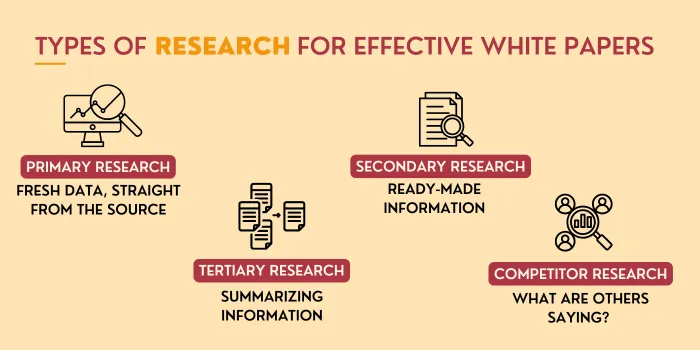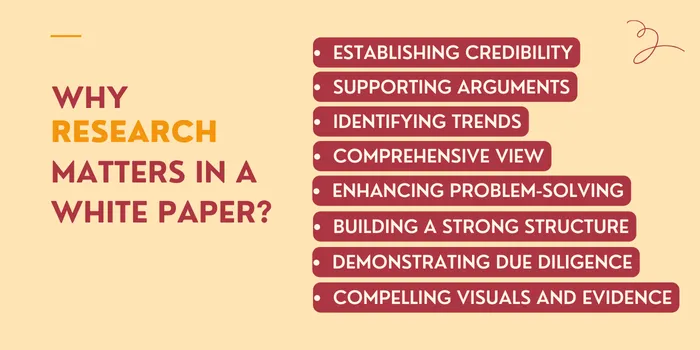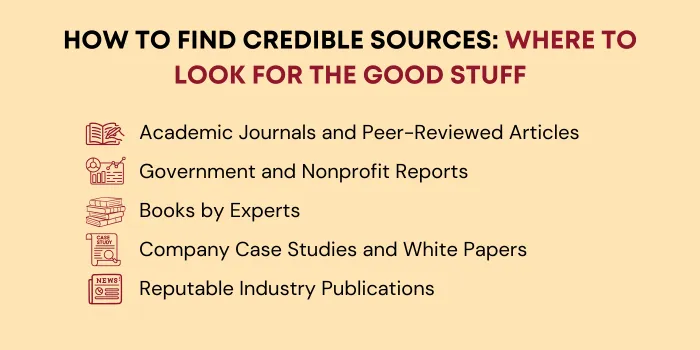

Creating effective white papers isn’t just about writing—it’s about combining research, strategy, and clear communication. A professional white paper writing service knows how to blend data-driven insights with compelling storytelling to engage readers and drive results.
When comparing a white paper vs case study, both serve distinct purposes, but a white paper typically offers broader industry insights and solutions, while a case study focuses on specific examples and results from real-world applications. So, what goes into writing an effective white paper?
Let’s explore key elements that make the research process effective.
Creating an effective white paper begins with thorough, reliable research. White paper writing services typically follow these research types to ensure the content is insightful and credible. But what type of research yields the best results? Let’s discuss.

Primary research is gathering information firsthand. This could be through surveys, interviews, or even running experiments. For example, if you’re writing an effective white paper about online learning, you might interview teachers or conduct a survey with students. Primary research gives unique, up-to-date insights that no one else has.
Sometimes, the best insights are already out there. Secondary research involves using published reports, articles, and studies. It’s like digging into a library of knowledge without starting from scratch. If you’re writing about market trends, reading industry reports can save time while offering valuable context.
Tertiary research takes secondary research a step further by organizing and summarizing information that’s already been published. This could involve looking at encyclopedias, databases, or indexes that consolidate existing knowledge. It’s useful when you need a quick overview or background information to support your secondary research.
For instance, in writing about a technology trend, referencing a tech encyclopedia or industry index might provide a broader historical context.
Qualitative vs. Quantitative Research
Competitor research looks at how similar topics or products have been discussed by others in the industry. By analyzing competitors’ white papers, articles, or case studies, you can understand what angles have been covered, identify gaps, and offer a unique perspective. This research helps position your white paper in a way that adds value and stands out in the market.
Research is the backbone of an effective white paper. It builds credibility, strengthens arguments, and positions your brand as an industry expert. Without solid research, even the most well-written white paper risks being dismissed as opinion-driven or incomplete.
White paper writing services ensure that your content is backed by thorough research, enhancing its authority and impact. Let’s understand why research matters for whitepapers.

If you want your white paper to be trusted, you need to use reliable sources like academic studies, industry reports, and expert opinions. Referencing reputable journals, well-known organizations, and quotes from respected professionals will help build trust with your readers. It’s also important to provide accurate and up-to-date information. Using outdated or incorrect data can harm your reliability, so always ensure your sources are current.
Include links to the sources you reference so readers can verify them themselves. Also, highlight your own expertise or your company’s experience in the field. Being transparent and mentioning any limitations or other viewpoints in your research builds trust too.
No one wants to read a white paper full of just opinions. To be convincing, you need data, statistics, and real-world examples. Research helps you find the facts that back up your claims and demonstrate the impact of the issue you’re addressing. This makes your white paper much more compelling and persuasive.
Use numbers to add credibility, real-world examples to show practical results, and expert quotes to reinforce authority. Comparative analysis highlights why your solution stands out, while historical trends build context and urgency. This transforms your paper from opinion-based to fact-driven, making it more convincing and trustworthy.
Research identifies industry trends by analyzing market reports, competitor performance, and customer behavior. Authors study historical data, current market dynamics, and technological advancements to spot patterns indicating where the industry is headed. They also track emerging challenges such as regulatory changes, economic shifts, or consumer preferences.
Through data analysis and expert interviews, they validate findings, ensuring the white paper addresses real-world issues. The paper offers actionable insights that help businesses stay ahead, making it a forward-thinking and reliable industry resource by forecasting potential outcomes based on these trends.
In-depth research allows the author to explore all facets of the topic, from historical context to modern-day implications. It ensures the white paper isn’t one-sided but provides a balanced perspective that includes different viewpoints and potential alternatives. This comprehensive approach not only educates readers but also shows a thoughtful, well-rounded examination of the topic.
Including contrasting viewpoints and possible alternatives demonstrates a deep understanding of the subject, making the white paper more engaging and trustworthy.
Effective white papers work best when they solve real problems with well-researched solutions. Research helps authors explore real-world challenges, find proven solutions, and present them clearly. Case studies provide examples of successful strategies, while expert opinions offer valuable insights. Industry reports add up-to-date data, making the proposed solutions more relevant.
Thorough research ensures that white papers offer practical, well-supported recommendations, helping readers make informed decisions and take meaningful action.
Research helps shape the structure of a white paper by providing clear, logical points to cover. Well-organized research allows for a smooth flow of ideas, with each section building on the previous one.
Research also helps prioritize important details, ensuring that the white paper remains focused and avoids unnecessary content. This structured approach makes the paper easy to follow, enhancing its effectiveness as a persuasive and informative document.
Thorough research signals to the reader that the author has put in the effort to truly understand the issue. It demonstrates due diligence, showing that the writer didn’t just skim the surface but dug deeper into the topic. This careful attention to detail enhances the white paper's quality and ensures the audience receives reliable, well-researched insights.
Research also fuels the creation of supporting visuals like graphs, charts, and tables. These visuals help break down complex data and present it in an easily digestible format. They not only enhance the white paper's appeal but also make the information clearer and more impactful.
The quality of your sources directly impacts the effectiveness of your white paper. You don’t want to just grab any data you find online—especially when some sources can be questionable. So, here’s where to turn to get the best, most reliable info:

If you’re looking for top-notch research, look no further than academic journals. These are the best of the best when it comes to solid, well-researched content. Peer-reviewed articles go through a rigorous check from experts in the field, so you know the data is trustworthy.
Start your search on platforms like Google Scholar, JSTOR, or PubMed. These sites are packed with studies and research that have already been thoroughly vetted by the experts.
Industry publications are another goldmine for reliable data. Well-known magazines, reports, and journals in your industry can provide current insights, trends, and data that professionals trust. Publications are packed with detailed reports that are often cited by industry leaders, so you know the information is credible.
Government websites and trusted nonprofit organizations often release detailed reports that are not only reliable but also unbiased. Sites like data.gov or reports from organizations like the World Health Organization or the United Nations provide data that is often free to access and up-to-date. These sources are a great way to get solid, evidence-based information for writing effective white papers.
Books written by experts in the field can provide valuable in-depth insights. But, here’s the key: make sure the author has credible credentials. Check that the book is published by a respected academic press or a well-known publisher. This ensures the content you’re referencing has been thoroughly researched and holds weight in the field.
Looking for real-world examples? Company case studies and white papers can give you a closer look at how certain strategies or technologies are being used in the industry. Just make sure you’re getting your case studies from reputable sources. Be cautious of documents that are too self-promotional, as they might present a biased view or leave out crucial information.
When creating a white paper, the format you choose often dictates the type of research you’ll need to conduct. If you’re drafting a thought leadership whitepaper, a market analysis, or a problem-solving guide, each format requires specific research methods to ensure that the content is both relevant and reliable.
To make this process easier, whitepaper writing services like Lexiconn can help you. These white paper writing services follow these approaches for each whitepaper type. Here’s a breakdown of research approaches for different white paper formats:
Technical white papers dive deep into a specific technology, system, or process. They are often aimed at professionals who require detailed explanations and data. The research methods for this format should focus on:
Market analysis white papers are focused on providing insights into market trends, consumer behavior, or competitive landscapes. The research here should include:
These papers identify a specific problem and propose a solution, often aimed at convincing the reader that a product, service, or approach is the best option. Research methods for this format include:
Policy white papers are usually aimed at influencing decision-makers or public opinion, and they require data that supports policy changes. The research methods should focus on:
These papers are intended to position the author as an expert in the industry. The research methods should focus on:
These papers are designed to attract and engage potential customers by providing valuable insights that address their pain points. The research methods for lead generation white papers should focus on:
Now that you’ve gathered your sources don’t forget to fact-check! It’s easy to get caught up in the excitement of finding interesting data, but it’s important to ensure everything checks out. Cross-reference your facts, look for up-to-date sources, and verify the credibility of your information. Your readers will appreciate the accuracy, and it’ll make your white paper much stronger.
Incorporating solid research into your white paper is essential, and if you are looking for white paper writing services for effective white papers, Lexiconn is here for you. We offer a 30-minute consultation to discuss your project and afree pilot so you can experience our quality firsthand.
Let our white paper writing services help you create a compelling, well-researched, and effective white paper that drives results. Contact us today to get started!



I have read and accept the Privacy Policy
Read More